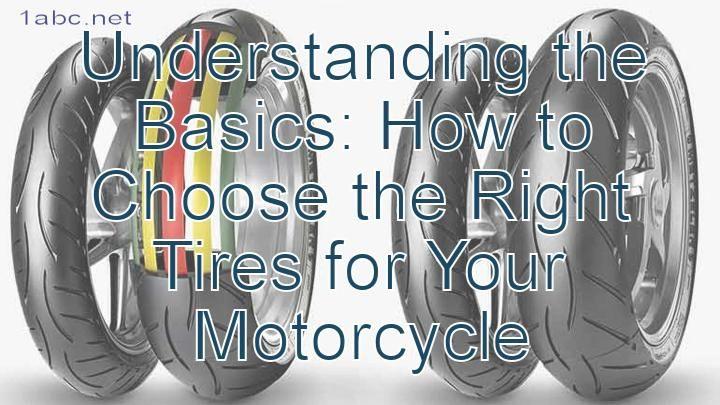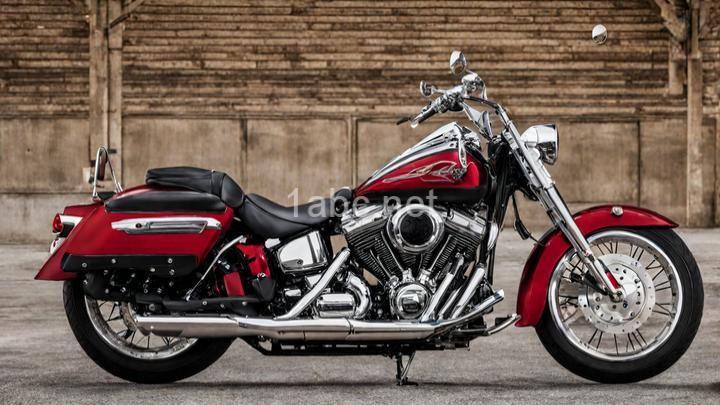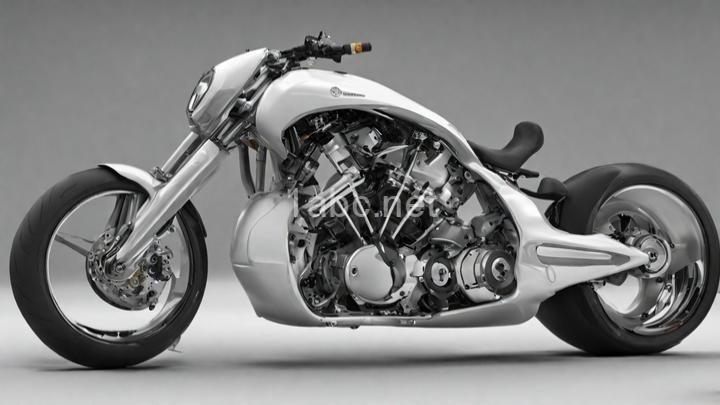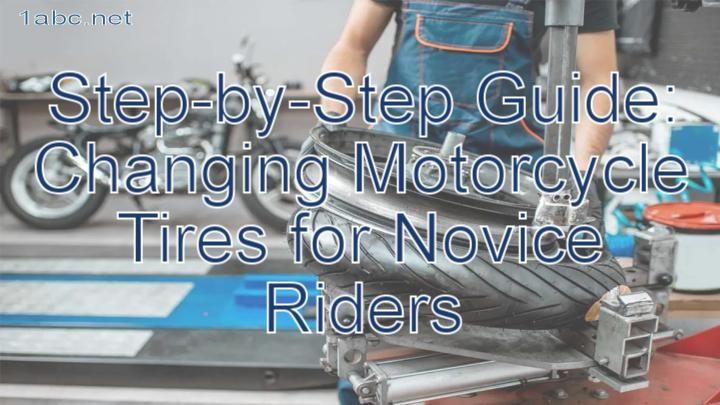Understanding the Basics: How to Choose the Right Tires for Your Motorcycle

Introduction:
Choosing the right tires for your motorcycle is crucial for both safety and performance. Just like shoes are essential for a runner, tires are the only point of contact between your motorcycle and the road. By understanding the basics of tire selection, you can ensure a smoother ride, better grip, and increased stability. In this article, we will guide you through the process of choosing the right tires for your motorcycle, from assessing your riding style and needs to decoding tire sizes and ratings, and researching brands and reading reviews. So, let's get started!
I. Assessing Your Riding Style and Needs:
The first step in choosing the right tires for your motorcycle is to assess your riding style and needs. Different riding styles require specific tire characteristics to optimize performance and safety. For example, if you primarily use your motorcycle for commuting, you would need tires that provide good grip and durability for everyday use. On the other hand, if you enjoy cruising on long road trips, touring tires would be a better choice as they offer comfort and stability.
Consider your primary riding environments as well. If you frequently ride on wet or slippery roads, you should look for tires that have excellent wet grip. Similarly, if you are an off-road enthusiast, you would need tires with aggressive tread patterns and reinforced sidewalls to withstand the rugged terrain. Lastly, take into account your mileage expectations. Some tires are designed for longevity and can provide higher mileage, while others prioritize performance and may wear out faster.
II. Understanding Tire Types:
Now that you have assessed your riding style and needs, let's dive into the different types of motorcycle tires available in the market:
- Street Tires: Street tires are designed for motorcycles used primarily on paved roads. They offer good grip, stability, and longevity for daily commuting or sport riding. Popular models include the Michelin Pilot Road 4 and the Bridgestone Battlax Sport Touring T31.
- Sport Tires: Sport tires are specifically designed for high-performance motorcycles and aggressive riding. They provide excellent grip, cornering stability, and enhanced maneuverability. Examples include the Dunlop Sportmax Q4 and the Pirelli Diablo Supercorsa SP.
- Touring Tires: Touring tires are ideal for long-distance riding and offer a balance between comfort, durability, and performance. They provide stability, good wet grip, and reduced road noise. Recommended touring tires include the Metzeler Roadtec 01 and the Continental ContiMotion.
- Dual-Sport/Adventure Tires: Dual-sport or adventure tires are designed for motorcycles that are used both on and off-road. They have a versatile tread pattern that provides good traction on various terrains. Popular models in this category are the Michelin Anakee Adventure and the Pirelli Scorpion Trail
II.
- Off-Road Tires: Off-road tires are specifically designed for motorcycles used primarily on challenging terrains like dirt, sand, or mud. They feature aggressive tread patterns, reinforced sidewalls, and increased puncture resistance. Examples of off-road tires include the Dunlop Geomax MX33 and the Bridgestone Battlecross X30.
III. Decoding Tire Sizes and Ratings:
Understanding tire sizes and ratings can be overwhelming, but it is essential for choosing the right tires for your motorcycle. Let's break it down into simpler terms:
- Width: The width of a tire is measured in millimeters and represents the distance between the sidewalls when the tire is mounted on an appropriate rim. For example, a tire labeled as 120/70 means the width is 120mm.
- Aspect Ratio/Height: The aspect ratio or height of a tire is represented as a percentage of the tire's width. For instance, a tire with an aspect ratio of 70 means the sidewall height is 70% of the tire's width.
- Rim Diameter: The rim diameter is the size of the wheel in inches that the tire is designed to fit. For example, a tire labeled as 120/70 R17 means it is designed to fit a 17-inch rim.
- Load Index: The load index indicates the maximum weight a tire can safely carry at the specified tire pressure. It is represented by a numerical value. For instance, a tire with a load index of 73 can carry a maximum load of 805 pounds.
- Speed Rating: The speed rating indicates the maximum speed at which a tire can safely operate. It is represented by a letter code. For example, a tire with a speed rating of V can handle speeds up to 149 mph.
When choosing tires for your motorcycle, make sure to match the appropriate tire sizes and ratings with your motorcycle's specifications. Consult your motorcycle's owner's manual or contact the manufacturer for accurate information.
IV. Considering Tire Construction and Compound:
Tire construction and compound play a vital role in determining the performance characteristics of a tire. Here are the key factors to consider:
- Bias-Ply vs. Radial Tires: Bias-ply tires have a diagonal or crisscrossed internal construction, which makes them sturdy and more resistant to punctures. They offer a smooth ride and are suitable for cruising or touring. Radial tires have a radial internal construction that provides better cornering stability and improved grip. They are commonly used in sport and high-performance motorcycles.
- Tire Compound: The tire compound refers to the material used in the tire's construction. Different compounds provide varying levels of grip under different road conditions. Some tires have a harder compound for increased longevity, while others have a softer compound for enhanced grip. Consider the weather conditions you regularly ride in—wet or dry—and choose a tire with a compound that performs well in those conditions.
- Tread Pattern Design and Wear Indicators: The tread pattern design affects the tire's grip and stability. Tires with deep grooves and aggressive patterns provide better traction on wet or loose surfaces, while tires with shallower treads offer reduced rolling resistance for better fuel efficiency. Additionally, pay attention to wear indicators on the tire. These indicators are small raised bars located in the tire's grooves that indicate when the tire needs replacement due to excessive wear.
V. Researching Brands and Reading Reviews:
When it comes to motorcycle tires, quality and reliability are paramount. Here are some reputable tire brands known for their performance and durability:
- Michelin: Michelin offers a wide range of motorcycle tires suitable for various riding styles and needs. Their tires are known for their grip, longevity, and innovative technologies, such as the Michelin Pilot Road series and the Michelin Commander
II.
- Bridgestone: Bridgestone is another trusted tire brand with a strong presence in the motorcycle industry. Their tires excel in performance, comfort, and durability. Popular models include the Bridgestone Battlax Hypersport S22 and the Bridgestone Exedra G852.
- Dunlop: Dunlop has a rich heritage in motorcycle tire manufacturing and is known for its performance-oriented tires. Their range includes tires for sport bikes, cruisers, and off-road motorcycles. Notable models are the Dunlop Sportmax Roadsmart IV and the Dunlop D605.
In addition to considering brand reputation, it is essential to read online reviews from fellow riders or professional sources. These reviews provide real-world experiences and insights that can help guide your decision-making process.
VI. Seeking Professional Advice:
While researching and reading reviews can provide valuable information, nothing beats the expertise of motorcycle manufacturers or trusted mechanics. They have in-depth knowledge about various motorcycle models and can provide personalized recommendations based on your individual needs. Don't hesitate to seek their advice to ensure you make an informed decision.
Conclusion:
In conclusion, choosing the right tires for your motorcycle is crucial for both safety and performance. By assessing your riding style and needs, understanding tire types, decoding tire sizes and ratings, considering tire construction and compound, researching brands and reading reviews, and seeking professional advice, you can make an informed decision that enhances both your safety and enjoyment while riding. Remember, the tires are the only point of contact between your motorcycle and the road, so choose wisely! Ride safe and have fun!
FREQUENTLY ASKED QUESTIONS
What are the key factors to consider when choosing motorcycle tires?
When choosing motorcycle tires, there are several key factors to consider:
- Tire Type: Determine the type of tire that suits your motorcycle and riding style. The main types are street, off-road, sport, touring, and cruiser tires.
- Tread Pattern: The tread pattern should match your intended riding conditions. Different treads excel in wet, dry, or mixed terrains.
- Tire Size: Check your motorcycle's owner's manual or consult a tire professional to ensure you select the correct tire size. It is important to match the tire size recommended by the manufacturer.
- Load Capacity: Consider the weight your tires need to support. Ensure the load capacity of the tires matches or exceeds the weight of your motorcycle and any additional cargo.
- Speed Rating: Pay attention to the speed rating, which indicates the maximum speed that the tire can handle safely. Make sure the speed rating is suitable for your riding style.
- Durability: Consider the tire's expected lifespan and evaluate its durability features such as puncture resistance, tread wear indicators, and overall construction quality.
- Brand and Reviews: Research reputable tire brands and read reviews from other motorcyclists to get an idea of the performance and reliability of different tire models.
Remember to consult with a tire specialist or motorcycle mechanic who can provide personalized advice based on your specific motorcycle model and riding preferences.
How often should I replace my motorcycle tires?
The frequency of replacing motorcycle tires depends on various factors such as the type of tire, riding conditions, riding style, and tire maintenance. However, as a general guideline, motorcycle tires are recommended to be replaced every 5,000 to 12,000 miles (8,000 to 19,000 kilometers). It is important to regularly inspect the tires for signs of wear, such as reduced tread depth or cracking, and replace them accordingly. Additionally, ensure proper tire pressure and maintenance to ensure longevity and safety.
Can I use any type of tire on my motorcycle?
No, you cannot use any type of tire on your motorcycle. Motorcycles require specific types and sizes of tires that are compatible with their design and function. The tire's size, load capacity, speed rating, and tread pattern must be suitable for your motorcycle. It is important to consult your motorcycle's owner's manual or a tire professional to determine the appropriate tire specifications for your specific model. Using incorrect or incompatible tires can compromise your safety and the performance of your motorcycle.
What are the signs of tire wear and when should I replace my tires?
Signs of tire wear can include the following:
- Tread Depth: As tires wear down, the tread depth decreases. Most tires have built-in tread wear indicators known as "wear bars." When the tire tread is level with these bars, it indicates that the tire is worn out and needs to be replaced.
- Uneven Tread Wear: If the tread wears out unevenly across the tire surface, it could indicate problems with wheel alignment, tire balance, or suspension components.
- Cracks or Bulges: Cracks or bulges on the sidewall may indicate internal damage or a weak spot in the tire. These can be dangerous and require immediate replacement.
- Excessive Vibration: If you experience excessive vibrations or shaking while driving, it can be a sign of tire wear or other issues. It's important to have it checked by a professional.
When to replace your tires depends on various factors, including driving conditions, tire type, and manufacturer guidelines. However, a general rule of thumb is to replace your tires when the tread depth reaches 2/32 of an inch (1.6 mm), which is the legal minimum in most places. However, it's recommended to replace them before reaching this point for optimal safety and performance. Regularly inspecting your tires and consulting with a tire professional is the best way to determine when it's time for replacement.
What is the difference between tubeless and tube-type motorcycle tires?
Tubeless and tube-type motorcycle tires are two different types of tire constructions commonly used in motorcycles. The main difference between these tires lies in the way they seal air within the tire.
- Tubeless Tires:
Tubeless tires have an airtight construction and do not require a separate inner tube to hold the air. The tire itself creates an airtight seal with the rim of the wheel. The inner liner of the tire along with the airtight bead seating provides the necessary air retention. Tubeless tires are generally classified as radial or bias-ply.
Benefits of tubeless tires include:
- Reduced weight, as there is no need for an inner tube.
- Lower risk of sudden air loss due to punctures as the tire's inner liner helps retain air even if the tire gets punctured.
- Better heat dissipation due to the absence of an inner tube, resulting in improved overall tire performance and reduced chances of tire overheating.
2. Tube-type Tires:
Tube-type tires, as the name suggests, require an inner tube to hold the air within the tire. The inner tube is inserted between the tire and the wheel rim and is responsible for maintaining air pressure. The tube usually fits snugly inside the tire and is inflated separately.
Benefits of tube-type tires include:
- Lower initial cost, as they are generally less expensive compared to tubeless tires.
- Easier repair or replacement, as only the inner tube needs to be addressed in case of a puncture.
- Availability in a wider range of tire options compared to tubeless tires.
Both tubeless and tube-type tires have their advantages and disadvantages, and the choice between them ultimately depends on factors like personal preference, riding conditions, and motorcycle specifications. It is important to select tires that are compatible with the bike and provide optimal performance and safety.



